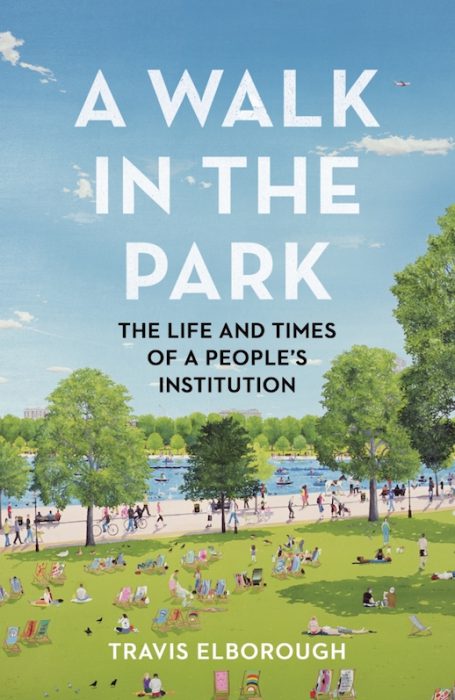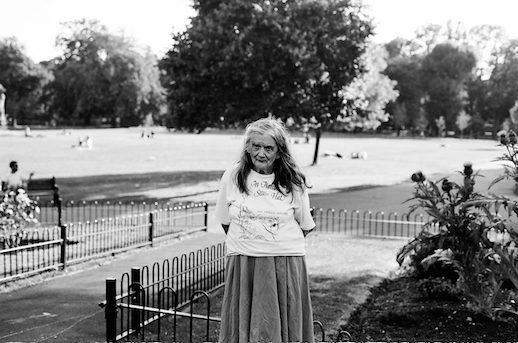A Walk in the Park: The Life and Times of a People’s Institution
by Travis Elborough. (Jonathan Cape, 384 pages, hardback. Published today.)
Review by Peter Watts
In his introduction to this richly entertaining history of parks, Travis Elborough makes no apologies for the fact his narrative may meander like a Sunday stroll through the local park and true to his word the book goes from Mesopotamia’s Epic of Gilgamesh to East London’s Olympic Park, taking in everything from Versailles lawns and Vauxhall pleasure gardens to Death Wish and Paul McCartney’s fondness for floral clocks. That scope seems fitting, as there are as many types of parks as there are things you can put in them, whether that be football, Lidos, bandstands or whimsical replicas of the Khyber Pass.
The latter can be found in Hull’s East Park, which opened for Queen Victoria’s Golden Jubilee in 1887 and is a great example of the sort of Empire-celebrating features that adorned parks during their first golden age, from 1885 to 1914. This was partly the result of battles fought decades before by characters like Gardener’s Magazine‘s one-armed publisher John Claudius Loudon, who had been arguing for the provision of public parks since the 1820s. Loudon was inspired in part by public gardens in Germany, which themselves were modeled on the great English country estates, albeit now paid for by the state and freely open to the public. Elborough traces the impact of such personalities, ambitious construction projects and international connections throughout his book, most notably in his chapter on New York’s Central Park, which was modelled on Merseyside’s Birkenhead Park, laid out in 1847 by Joseph Paxton of Crystal Palace fame.
It’s this Victorian era that proves most fascinating, as authority figures – the church, the state, posh do-gooders – embraced the park as a cure for whatever urban ills concerned them. Parks would save the poor from “drinking-houses, dog fights and boxing matches”. They would provide a place for military training. They would offer education in the form of classical sculptures or trees carefully arranged for the public to study like a living arboreal encyclopedia. A neat, landscaped park would replace the rambling common, where bands of disenfranchised citizens could gather to protest or riot. They would provide employment for idle hands during periodic downturns. They would encourage the public to spend more in shops, so as to look their best when promenading of a weekend. And they would be a place for the public to gaze upon the spoils of war and Empire, whether in the form of borrowed architectural conceits like bandstands, captured Russian guns or Afghan-inspired follies.
Uniting these disparate desires was a common sensibility: that the country was good and the town was bad, so any attempt to bring the country into town would result in moral improvement. This is a Biblical conceit – think Eden and Sodom – and in the 1970s and 1980s, parks once more became the centre of this sort of debate as they fell into steep decline, a result of economic and urban crises that were solidified into hard economic policy by the budget-cutting, city-hating Conservative government. Elborough introduces this section with reference to Gary Numan’s “Down In The Park” – he’s as adept at weaving in pop culture references as he is lightening the sometimes dense history with sly asides – which portrays the park as a dystopian hell, populated by “rape machines” and robotic assassins. This era see the park become a community liability rather than asset. By 1994, less than 10 per cent of the UK’s urban parks had cafes or refreshment kiosks and only 25% had toilets. The fall was arrested by Heritage Lottery Fund money allied with the increasing fashion for urban living by the middle classes, who arranged themselves into Friends groups, fostering a second golden age of parks, one of imaginative restorations, new treatments of landscape and a wider range of facilities, as well as concepts such as linear parks and nature parks reclaimed from landfill sites and railway sidings.
A good park, like my local one in Herne Hill, now serves the needs of many, and can offer its public cradle-to-grave facilities, from toddler swings and paddling pools through bike tracks, sports pitches, picnic areas and community greenhouses all the way to a walled garden of formal flower beds spotted with commemorative benches to deceased parkgoers who, invariably, are remembered as having “loved this park”. You can live your life within a good park, communally or alone, while enjoying decent ice cream and working loos. Some even have wi-fi.
These near universal improvements came to a halt with the crash of 2008, and Elborough ends on a cautionary note, with the pressure on council budgets and on land leaving the future of public parks “more imperiled than it has done for some time”. The irony is that parks are now appreciated and understood as never before, welcomed for their improvements on everything from mental health and physical wellbeing to the environment and house prices. There is once again consensus on their benefit, but not on how they should be paid for – a gap that provides both opportunity and threat, with the overlapping needs and competing interests of creative councils and commercial developers drawing a new front line on our beloved national parkland.
————————————————–
Travis Elborough will be reading from A Walk in the Park at Caught by the River Thames on Sunday 7 August.
Up In Smoke: The Failed Dreams of Battersea Power Station by Peter Watts is out now. Read our review here.

